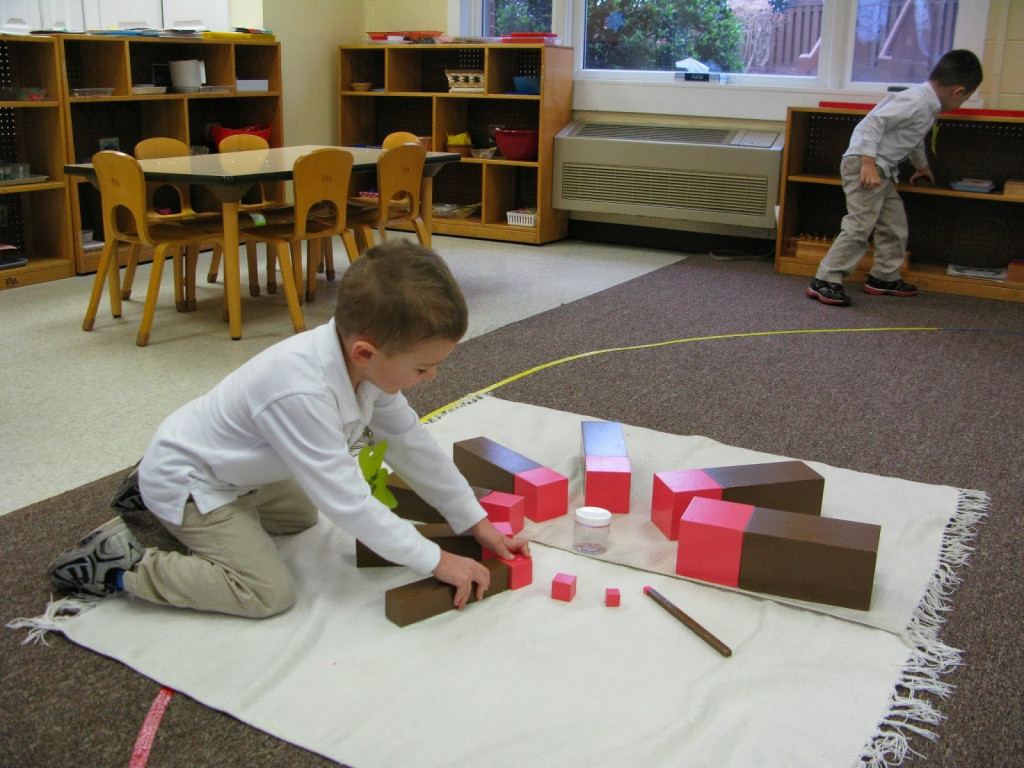A young child can remain unmoved by a myriad of sensory impressions in her everyday environment. What she needs is not more and more impressions buy the ability to understand what she perceives. The Montessori Sensorial Materials help the child to distinguish, to categorize, and to relate new information to what she already knows. Dr. Montessori believed that this process is the beginning of conscious knowledge. It is brought about by the intelligence working in a concentrated way on the impression given by the senses.

Pink Tower:
Size in three dimensions is introduced to the child by the use of the Pink Tower. This is a series of ten pink cubes graded in size to form one centimeter cubed to ten centimeters cubed. The child builds a tower beginning with the largest cube and ending with the smallest cube on top.
Brown Stairs:
The Brown Stairs introduces the child to the difference in size– two dimensions. The child must place the blocks in proper graduation forming a stair – like structure. With this exercise the teacher introduces the concepts of thickness and thinness, using the terms thick, thicker, thickest and thin, thinner, thinnest.
Red Rods:
The Red Rods help the child to recognize differences in size in one dimension–length. The child is introduced to the terms short, shorter, shortest and long, longer, longest. The equipment gives the child a sensorial basis for learning to count when he begins mathematics.
Smelling Jars:
The food is covered by cheesecloth or a perforated top so that the child smell it, but she can’t see or feel it. Each har in the first set has a mate in the second set. The child combines the pairs by carefully smelling each jar. The teacher uses this exercise as an opportunity to build the child’s vocabulary by teaching her the names of the foods she is smelling.
Color Tablets:
The child’s first introduction to color is a box containing six tablets–two red, two blue and two yellow. They differ only in highly contrasting color. In this exercise, the child pairs the tablets and learns the corresponding names.
Grading the colors:
For the next step the child may use a box containing eight different shades of eight different colors. The child must distinguish the intensity of the shades and place the tablets in order from the lightest to the darkest shade of each color. Teaching children to be aware of fine differences in color is giving them remote preparation for all kinds of scientific observations, art, art appreciation, decorating, and many other meaningful activities.
Art Postcards:
This exercise enables the child to become familiar with the details of art while refining her visual discrimination.
Baric Tablets:
A box containing three sets of little blocks of wood, each set varying slightly from the other two in weight. The blocks also differ in color, so that the child wears a blindfold while doing the exercise. This eliminates the visual difference and enables the child to sort the blocks by weighing them on the tips of their fingers.
The Art of Listening:
The art of listening carefully is a quality worth cultivating for a lifetime. Listening attentively is a vital preparation for reading. Montessori designed several sensorial games to help the child concentrate on a particular sound.
The Montessori Bells:
Another quality of sound that is interesting to the child is pitch. To isolate this quality, Montessori designed a set of black and white bells corresponding to the black and white keys on the piano.
The Art of Feeling:
A child loves to touch. Much of the world comes to him through his hands as he investigates everything in his environment. He can use the sense of touch in a more meaningful way if he wears a blinfold. This eliminates recognition of an object and challenges him to recognize something with only his sense of touch.

